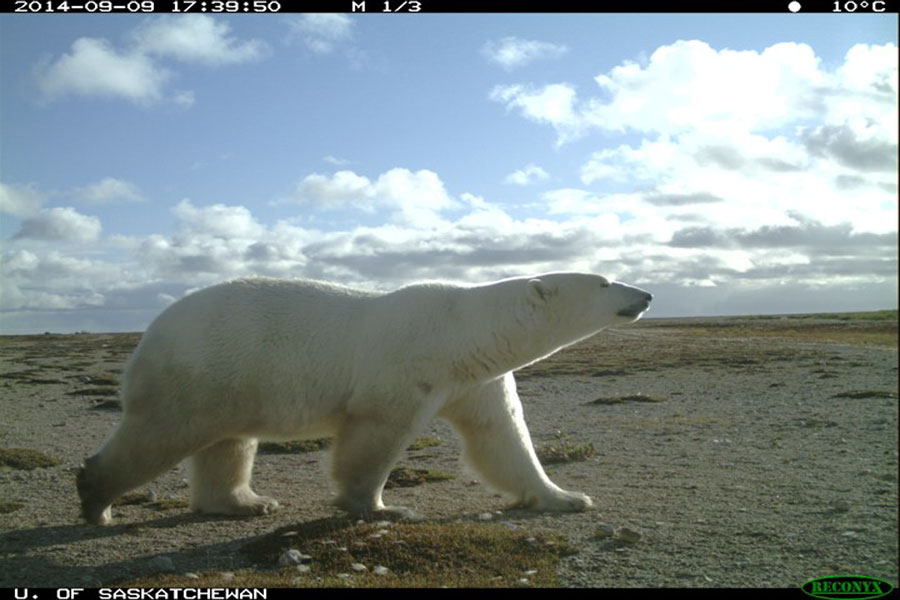‘Citizen Scientists’ Help Researchers Gather New Insights Into Polar Bear Behavior

OXFORD, UK – Oxford University is working with Canadian researchers on a first-of-its-kind project that will engage citizen volunteers to help advance knowledge about polar bear behavior in a changing environment by analyzing a decade’s worth of images captured by trail cameras.
The Arctic Bears Project is being led by Professor Douglas Clark, of the University of Saskatchewan, in collaboration with penguinologist Dr Tom Hart of Oxford’s Department of Zoology.
Launched officially to coincide with International Polar Bear Day on 27 February, the project runs on the Oxford-based Zooniverse.org – the world’s largest online platform for citizen science, with more than two million volunteers worldwide assisting researchers across almost every discipline to annotate and organise data.
Professor Clark said: ‘This is a totally different way to do polar bear research. It’s non-invasive, it involves the public for the first time, and it’s being done in a way that can carry on through the pandemic without endangering anyone in northern communities.’
Non-invasive research is of considerable interest to Arctic communities because it’s not stressful for animals, added Professor Clark.
Dr Hart has already used Zooniverse to assist with his Penguin Watch and Seabird Watch projects. He’s helping Professor Clark and his students to set up the polar bear project by aggregating and uploading data, and will also work on the analysis.
Dr Hart said: ‘We’ve gained so much through citizen science in the polar regions. In contrast to Antarctica, the Arctic is inhabited and so being responsive to Arctic communities is vital to gathering data and solving problems. I am delighted to help with the Arctic Bears Project – it’s addictive and I love getting to see some of the diverse animals of the tundra.’
Professor Clark added: ‘This allows people, who might otherwise just passively consume images on TV and social media, to participate in polar bear research and understand how these bears are interacting with people and other wildlife in what we know is a rapidly changing environment. Volunteers can help us process data in ways that are incredibly labour-intensive, which otherwise would take us and our students years to do.’
Volunteers are supplied with a field guide and asked to provide information on the number of bears in photos, their gender, cubs, body condition and other factors, choosing from provided options. Beta testing with over 60 volunteers showed the process works well. The photos – taken at Wapusk National Park in northern Manitoba – will be uploaded in tranches over the coming months, allowing volunteers to work through one batch before moving on to the next.
The research project began in 2011 when Professor Clark was asked by Parks Canada to find out if the field camps it established in Wapusk attracted or repelled polar bears – a question that still hasn’t been conclusively answered.
Other questions the team is trying to answer are:
- What are the drivers of polar bear visits to human infrastructure / activity? For example, is it environmental, is it a result of a lack of sea ice/nutritional stress, or is it a response to human activity?
- Are there changes over time in where/when polar bears, and all the other Arctic and boreal species seen in the photos, are observed?
Researchers have installed five non-invasive trail cameras at each of three field camp sites, and eight more at the Churchill Northern Studies Centre. They operate year round and have captured more than 600 discrete polar bear observations over ten years, along with images of other species such as wolf, caribou, grizzly bears, moose, Arctic and red foxes, and even occasional wolverines.
The four sites are along the Hudson Bay coast and are separated by almost 200 kilometres, across the ecological boundary between boreal forest and tundra, providing invaluable data on multiple species in a changing environment.
Ryan Brook, an associate professor at the University of Saskatchewan, is taking advantage of the lucky ‘by-catch’ of Professor Clark’s project – the images of caribou and wolves – to conduct research on these species at a time of Arctic warming and changing weather patterns.
About Oxford University
Oxford University has been placed number 1 in the Times Higher Education World University Rankings for the fifth year running, and at the heart of this success is our ground-breaking research and innovation. Oxford is world-famous for research excellence and home to some of the most talented people from across the globe. Our work helps the lives of millions, solving real-world problems through a huge network of partnerships and collaborations. The breadth and interdisciplinary nature of our research sparks imaginative and inventive insights and solutions. Through its research commercialization arm, Oxford University Innovation, Oxford is the highest university patent filer in the UK and is ranked first in the UK for university spinouts, having created more than 170 new companies since 1988. Over a third of these companies have been created in the past three years.



Comments are closed.